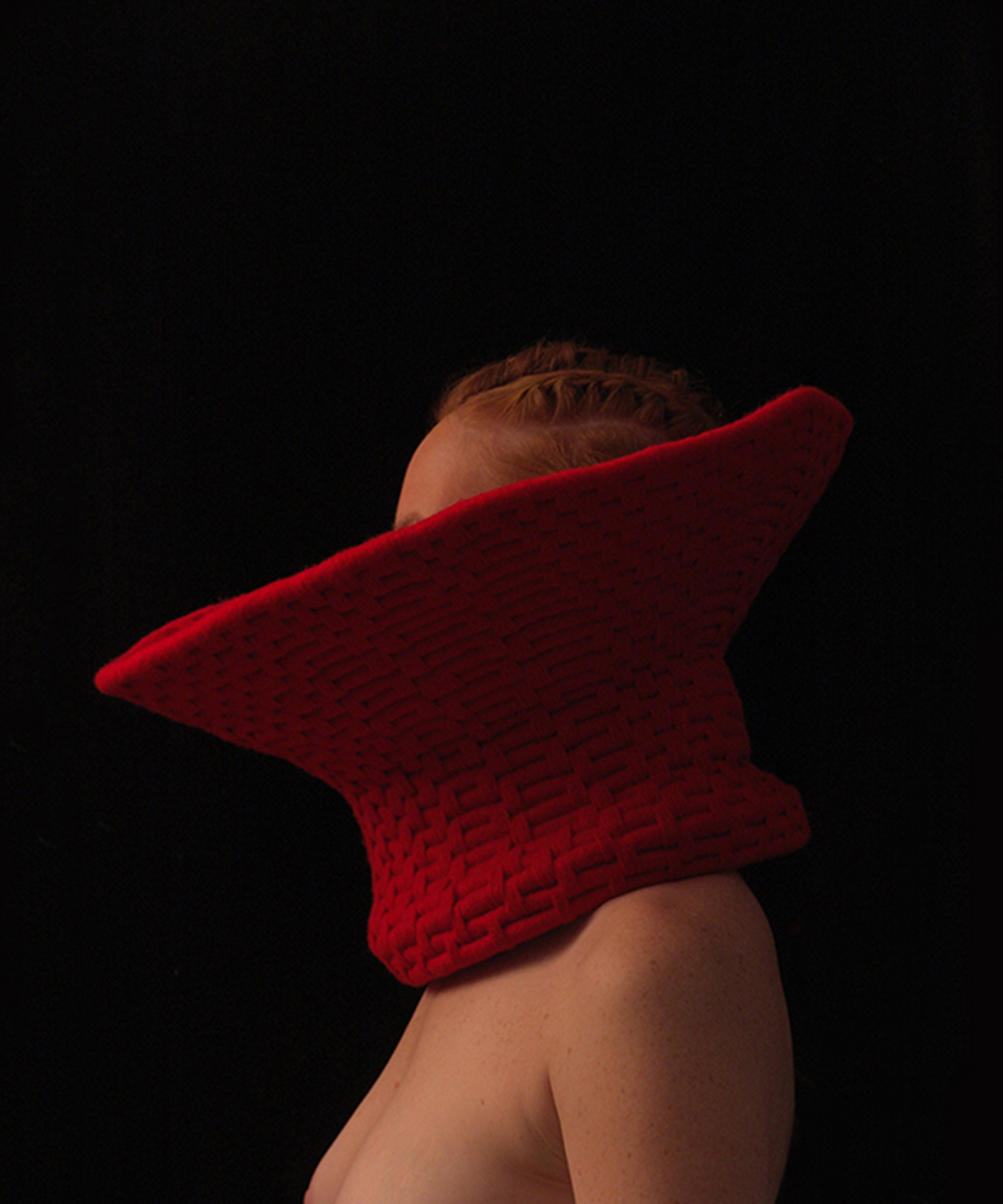This roundtable discussion occurred in Detroit with the following participants: Laura Mott, Curator of Contemporary Art, Cranbrook Art Museum; Taylor Aldridge, Assistant Curator, Detroit Institute of Arts; artist Tiff Massey; and artist Matthew Angelo Harrison.
Laura Mott: Taylor and I initially began working together when she assisted me last year with preliminary research for a future exhibition at Cranbrook Art Museum titled Landlord Colors. The research focuses on Detroit artwork from the late 1960s to the present in relation to four international art scenes, and seeks to understand the city through materiality. We chose the material of rust as a starting point because of its conceptual possibilities that extend to themes of space, time, duration, lived research, and storytelling. Our first roundtable discussion published in this edition of Art21 Magazine was with Olayami Dabls and Carole Harris, two venerable artists from Detroit with decades-long careers, who directly use rust as a material and metaphor in their artwork. You both are born-and-bred Detroit artists, and your recently established careers are distinctly exploratory in your approach to material, conceptual tools, and issues surrounding identity and authenticity.
Taylor Aldridge: Tiff, I know that you’re really invested in the color black as a metaphor, a material, and a device to talk about cultural history as it relates to Detroit. Your background is in metalsmithing, but recently you have been researching black and white alabaster, and you participated in a residency dedicated to that material in Italy. Can you talk about your experience there?
Tiff Massey: I was in Volterra, Italy, for two months. Alabaster is softer than marble, and I didn’t have a hard time using the tools because they are very similar to those used in metalsmithing, especially for finishing. The challenge was that I had to work in a subtractive method while I usually work in an additive method. In Volterra, I met one guy who was trying to preserve his grandfather’s alabaster studio, where everything was still in place since his grandfather last touched the material. He talked about how generations have worked with it and about their camaraderie. He explained that they lived in the front room, and his grandfather’s studio was in the back room; eventually they made enough money to own the entire dwelling. Just the idea of living off the material is really interesting.
During the annual Alabaster Festival, toward the end of my trip, I heard there were historical ties between alabaster and political anarchists. [Knowing this] probably would have informed more of the things I was making, but I think that my guide, who was in charge of telling me local histories, was skipping over this. My aim was to make moving chains out of alabaster.
TA: Can you talk about the process of creating your wearable chain sculptures and where that motivation comes from?
TM: My interest in creating chains comes from growing up in the 1980s and being heavily influenced by hip-hop. I watched the transition in hip-hop jewelry, from being heavily reminiscent of how African kings would adorn themselves, to platinum being the best material to adorn oneself. I noticed the designs and how certain symbols would be associated with certain groups within the industry. Growing up in Detroit, nobody wants to look like another person. These wearables are my paintings, and it’s hard for people to understand that I’m using the body as a site to articulate my ideas. Recently, I started to increase the scale of the chains, and now I’m thinking about the public realm and how people can interact with the work in a different way: I see people walking through it.
TA: Matthew, the concept of post-identity is mentioned in your previous interviews, and it’s really interesting to me that you often work with African masks or create low-tech, 3D-printed African masks. So these emblems of identity are created by you, yet you’re grappling with themes that are related to post-identity.
Matthew Angelo Harrison: I’m really influenced by museum display, by the relationship between the object and the mentality that an observer has toward the purpose of it being displayed. I’m attracted to the possibility of an individual’s identity being lost in abstraction over time—abstraction through different mediums and interpretations—and ending up with a kind of surveillance of what the identity was. I thought that repetition was an important tool in communicating that, and 3D printing and technology is fundamental for repetitive production.
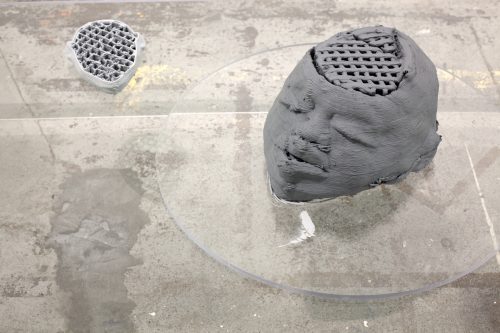
Matthew Angelo Harrison, clay reproductions from installation at Museum of Contemporary Art Detroit, 2016. Courtesy of Jessica Silverman Gallery.
LM: It’s interesting that you refer to the museological, especially when talking about older objects created before the twentieth or twenty-first century. The museum object is so far away from its origin, and everyone brings interpretations to that object; this happens a lot in historical and anthropological museums. This creates space for storytelling, but it can also be a dangerous space. As with people, a lot of times museums tell a story that benefit their interests. In your work, you talk about the prototype, which is a complicated and fascinating way to think about unique objects from a different time. The term prototype is from the language of industry, but what happens when the meaning of something is replicated over time, perhaps misappropriated, and is so far away from its origin?
MAH: My day job is working as a clay sculptor for the Ford Motor Company, and one of my biggest concentrations is prototyping, the ability to remake something in a slightly different way for a slightly different purpose. Designing objects are important to my job and how I think about my artwork. It really influences my idea of preciousness or value systems in general. Here, working on billion-dollar projects or campaigns, I’m sculpting something that’s going to be on a million cars, or the idea might die in the studio process.
When one reprints an object, it becomes more abstracted; there’s less detail in it. In my artistic practice, I’m hand-making 3D printers with low resolution, so I’m facilitating the degradations and differences. In my next exhibition, I’ll be juxtaposing relics, like masks, alongside 3D prints of them. I’ll display the real ones in cases, and the 3D-printed objects will probably be on pedestals to relate the material forms of both versions. They represent different things and times, so having them together is an important juxtaposition. What is interesting is that collectors are now asking if I will scan items they own, like African masks.
LM: What’s at stake when you do something like that? What happens if you are no longer the selector, no longer designating “the prototype”?
MAH: Maybe it’s a betrayal to those objects, using them that way and separating them from the context I create. I think industry is not the quintessential defining factor between the African and African-American identity. When I say African-American, I mean people from any of the Americas, anybody influenced by a colony. Everything comes from industry, right? I think of industry as something that has directed the Black identity. My mom used to work at the American Axle factory in Hamtramck [a city within Detroit], and now I have an artist studio down the street from it. I think about the effects that industry has had on sub-Saharan Africa and the resources there, and I think about the whole art market and how we trade objects that used to belong to specific cultures. I’m also interested in counterfeits. I scan a lot of them. I scanned a good fake that pre-dates ninety-nine percent of sub-Saharan African masks. It’s interesting to reproduce that and question what’s “real”.
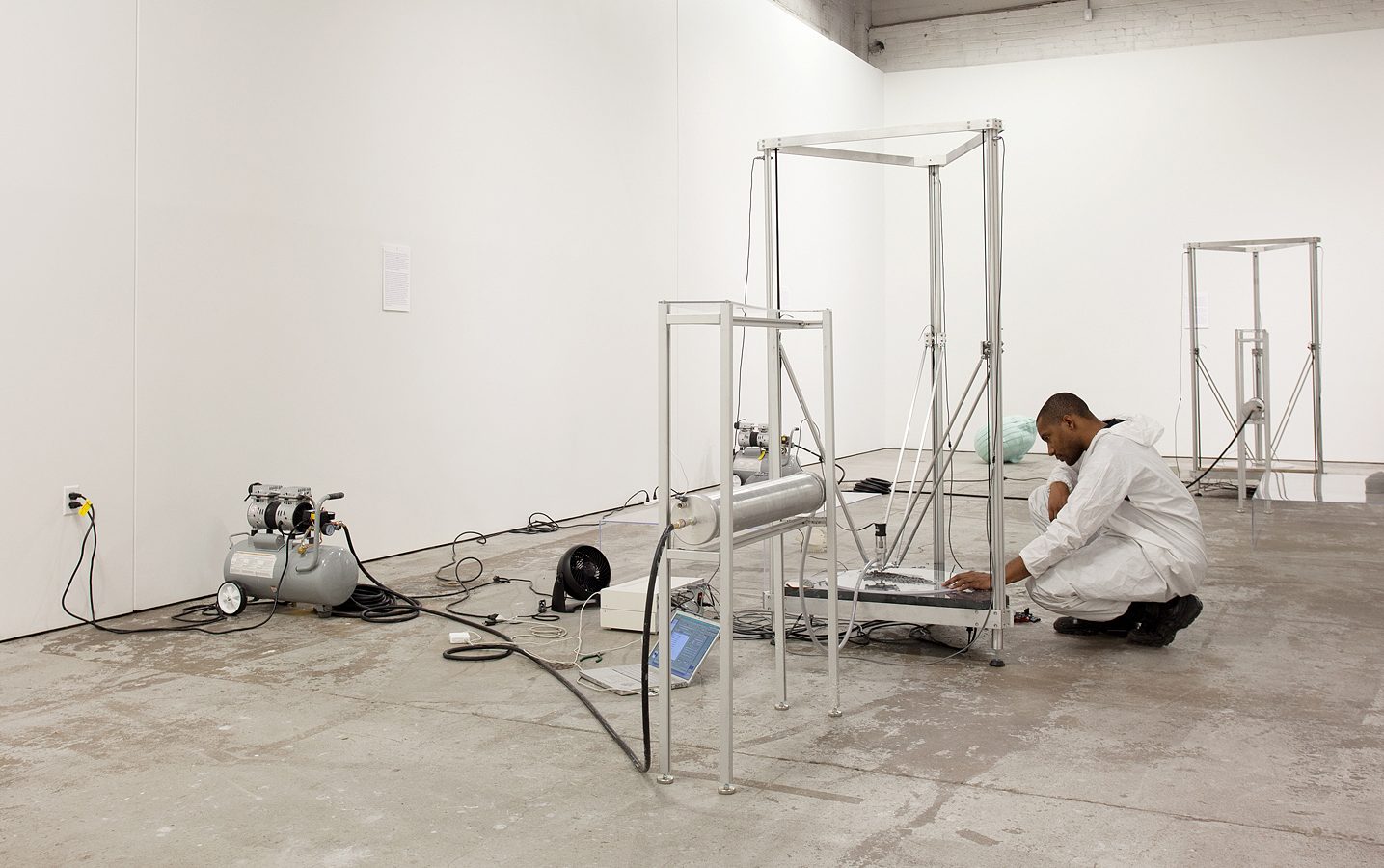
Matthew Angelo Harrison, installation at Museum of Contemporary Art Detroit, 2016. Courtesy of Jessica Silverman Gallery.
TA: I think it’s important to point out the differences between your day job and your artwork. For the job, you’re creating a design to be mass-produced, over and over again, and multitudes are going to have this object. In the art world, best practices dictate you create limited editions or one-of-a-kind objects that have a higher value. How does that value system relates to your process?
MAH: Suppose I’m designing a steering wheel for a Lincoln. And that [design prototype] is made of clay, but [the final product] is made of steel, rubber, and synthetic plastic. When I’m 3D-printing something made of wood, I reproduce it in stoneware or plastic, and I have to set limits. I can’t just print fifty more to sell. [The process] changes the first object and affects the last one, too. In my work, it’s like you have the beginning and end of the sentence at the same time, so they are presented equally. So it’s up to the viewer to decide where it belongs in time.
LM: That’s similar to why we were interested in the topic of rust; we start with the material at the end of the story and work backwards. I think the link between some of the things we are talking about is authenticity and where it resides. Tiff, can you talk about the notion of authenticity in your practice?
TM: My jewelry practice is still making one-of-a-kind pieces; you find your match. But I’m getting to how Matthew thinks about his work, making limited editions for some objects. The commercial jewelry game functions that way, so it’s interesting that I make jewelry and am not working in this realm, because they say, “time is money, time is money”…[Laughter]
For me, it’s more about appropriation than authenticity: who is the owner, and who has ownership? In a lot of the works, I have been dealing with body parts, specifically hair. African hair traditions, often lost, were used as status symbols, which is why I’ve created adornment from designs that would normally be crafted with one’s hair. I’m returning to and incorporating previous works because I’m not satisfied with how I’ve used them. I’ve started to make music, photographs, and films to give more context to the material because I think some wearables need to be performed to be understood. For instance, I’ve used White models with African hairstyles, [positioned] in frontal and profile poses that one would usually see in mug shots. I’m showing these designs without a visual representation of their origin, intention, and context. [As a result] everyone asks, “Why do you have White models?” because it looks like there should be some brown skin underneath.
LM: Matthew, you draw from art-historical ideas of the unique object and appropriation as well as refer to Arte Povera [translated as “poor art”], the Italian art movement in the 1960s and ’70s, which is one of the movements part of the research for Landlord Colors. The Arte Povera artists rebelled against capitalist homogeneity and used materials from nature or left over from industry. The movement corresponded to the Years of Lead, which was a volatile, riotous period beginning in late-1960s Italy, and the rejection of mass production informed the Arte Povera aesthetic. You casually refer to your practice as Dark Povera. I’m interested to hear your perspective on that art history and how you’ve made it your own.
MAH: I’m surveying my relationship to that art history; Dark Povera is a “dark and poor” play on that identity. Arte Povera resisted the idea of identity works, of things made in the image of the artist, as opposed to things made through the artist’s observation. I’m building from that lineage and inserting identity into it. I also think about the political context of postwar Italy and that of Detroit now and see where those overlap. Most of the Arte Povera core ideas were eventually abandoned by those artists [as they produced art beyond that time period]; that’s the consequence of living in an industrialized art world. I also relate to artists like Liam Gillick, whose works refer to “the factory” and are products of industrialized art practices.
TA: In our recent roundtable discussion with Carole Harris, she explained how she sees beauty in a decayed object and that she is interested in witnessing the shedding of a building’s layers as a result of time and other elements. Decay is such a loaded word because it makes us [Detroiters] immediately think of outsiders taking ruin-porn pictures, focusing on all of the vacant buildings that are deteriorating here. However, I would love to hear your perspectives on how you’re thinking about the outcomes of your works and the effects of time.
MAH: I think about decay and degradation in a nonmaterial way. I think about the perception of something that I print or reproduce. All these reiterations are interesting because they are an attempt at immortality, like some sort of spiritual practice or entity, but this attempt also can lead to its meaning being destroyed or manipulated.
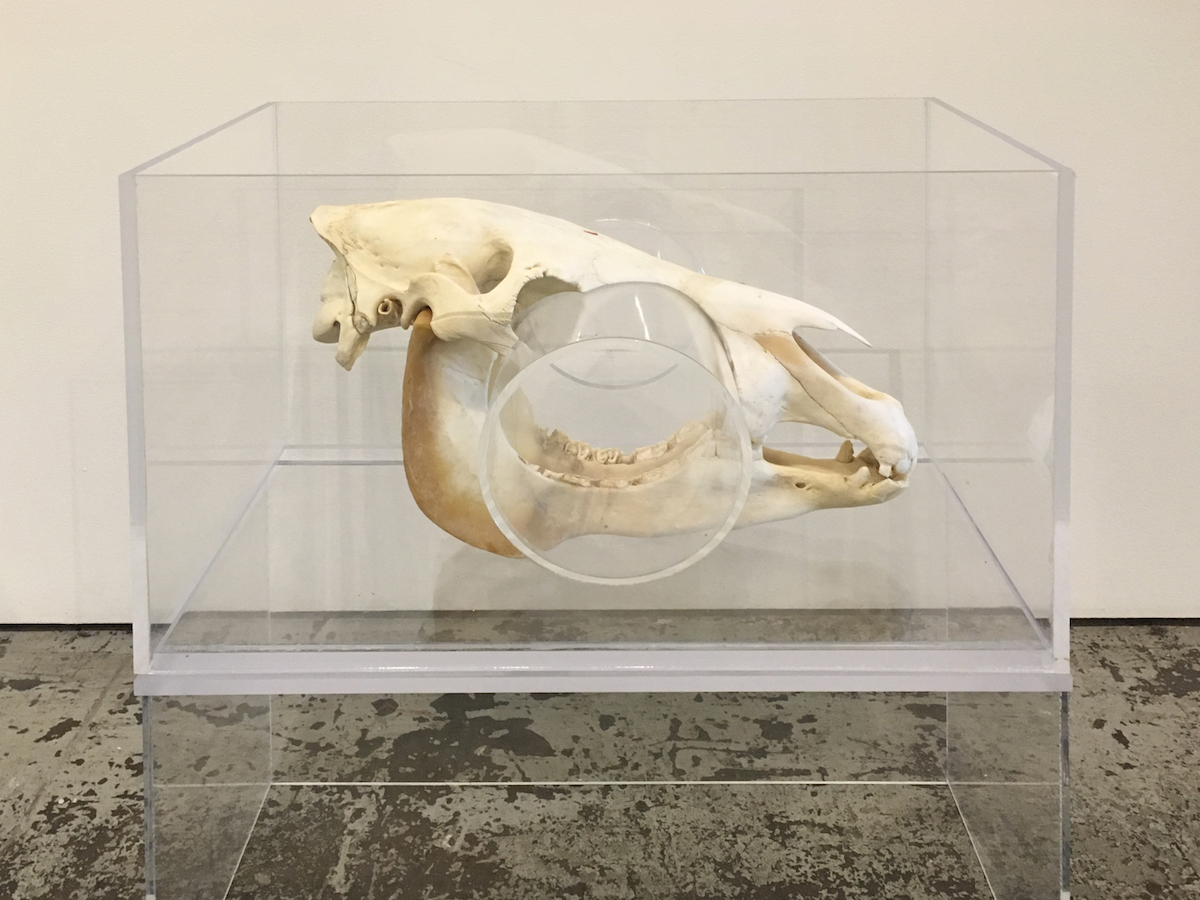
Matthew Angelo Harrison. Hole 1.005 The Consequences of Synthetic Apertures, zebra skull, automotive clay, acrylic, 2016. Courtesy of Jessica Silverman Gallery.
TM: I have outdoor works that I let decay because then it becomes part of the history of the piece. The look of some of my jewelry totally changes the more one wears it, and I’m very interested in the end result. Wearing the jewelry will constantly chip away the coating, but there will always be a new look.
LM: There is an ongoing battle about the representation of Detroit in the cultural scene, which is why the notion of decay is so complicated. It’s difficult to explain the emotional dynamics of the tension at the scale of a city like Detroit, which is where visual language comes in. Do you feel a responsibility to Detroit’s representation?
TM: It’s kind of hard for me to separate my narrative from my work, and I’ve been thinking about who controls the narrative, especially as a native from Detroit. I’ve been making work to combat those narratives, based on being nostalgic about this city. Usually Detroiters are die-hard lovers of their Detroit. It’s really interesting that industry and corporations are now trying to join the bandwagon, like they just discovered a new island somewhere. So I thought it was important for me to stay true to the ground and be able to tell the true story. I’ve been using a lot of visual representations of the city, from as far back as I could find. People talk about the heyday, when [the city’s future] was so bright, but then the rebellion came in 1967, and that’s when the name Detroit essentially became a pejorative. A lot of times, I’m looped into these public conversations about Detroit, because I’m the token: a Black girl from Seven Mile Road who has a master’s degree from Cranbrook and who is a metalsmith. I check them all off.
TA: You’re a token and an anomaly. In a recent show, part of the St. Etienne Design Biennial, we [Public Design Trust] incorporated your wallpaper work that is a visual vignette of Detroit’s history. I was really excited to see that story told through that medium, yet surprised to see that you were working with wallpaper because you primarily work with three-dimensional objects. Your practice coupled with your background places you in a unique position to have a broad skill set that’s invaluable to the arts community here, in regard to telling authentic narratives.
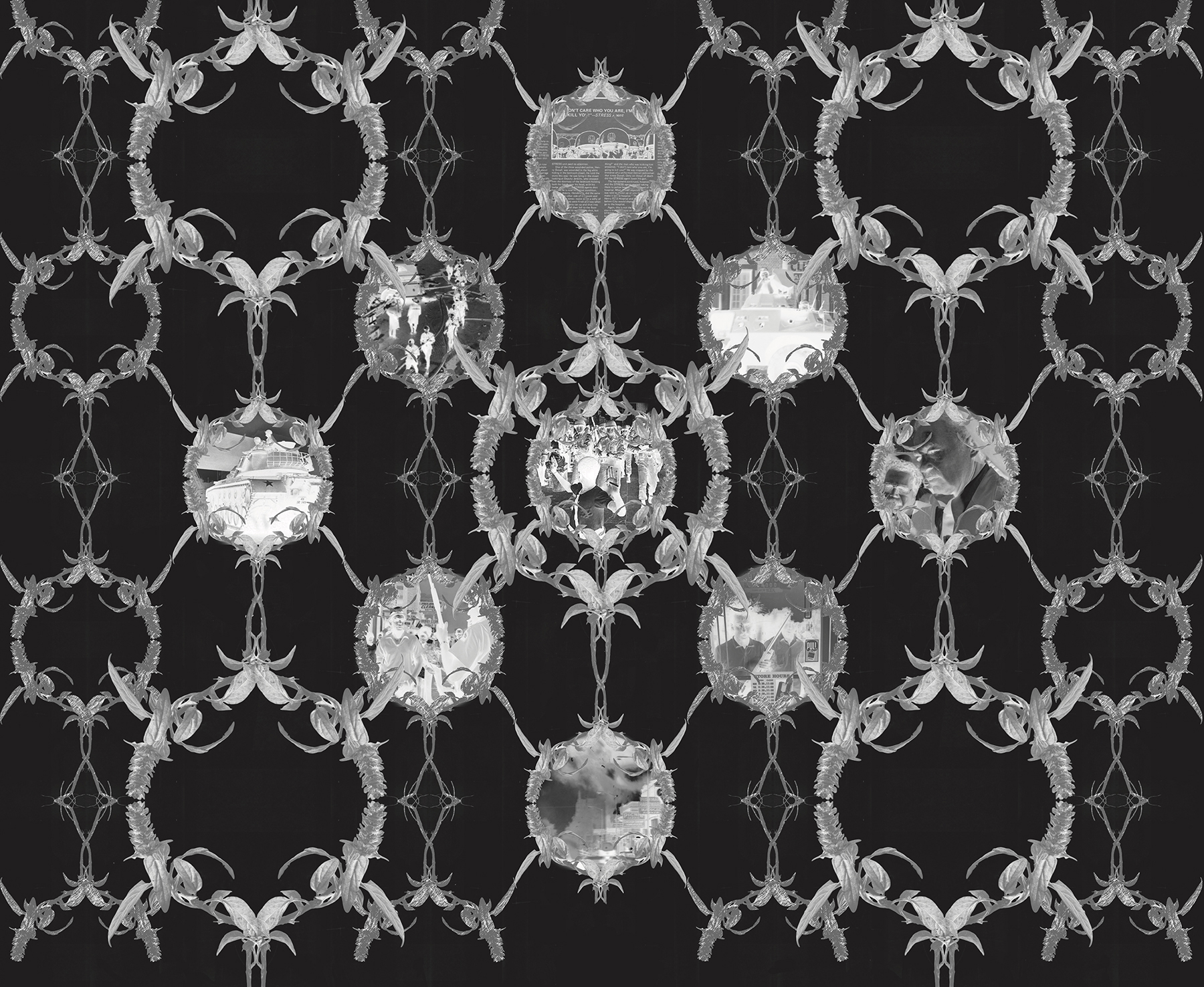
Tiff Massey. Detroit Flore et Faune, 1920-1960s (B(l)ack Then They Didn’t Want Me Now I’m Hot They All On Me series), wallpaper, 2016. Courtesy of the artist.
TM: When it comes to the conversation of responsibility, it’s like at the end of the day, I know the stereotype, what people see or think first. A lot of times, when I deliver my sculptures, some one will ask the nearest White man about them because the narrative of [who] an artist or sculptor is describes him, not me. Writers come to Detroit for two days and say, “Oh, Detroit’s amazing!” but we still don’t have streetlights in some areas; we still don’t have water in some areas; we still don’t have schools. So it’s kind of hard for me, when the lights shines on me for my efforts in art, because we have some real shit happening that needs more attention.
MAH: So much of that looking back still applies to industry here and its decline. Places like California and Nevada have new forms of industry and postindustrial work, like web development, that have taken over. Those are not labor jobs; everything is more automated. Industry here is so behind, and everybody who works in it knows it, except the people who ignore it because they’re economically comfortable. It’s another case of the one percent at the top holding out and refusing to accept the future.
LM: Well, nostalgia is a very potent political tool, as we’ve seen. The recent presidential election was essentially won not on an idea of the future of America but on a severe edit of the past. Obviously, the future won’t resemble the past of fifty or sixty years ago. Nostalgia is interesting because people misremember things at a certain point: they fill in the gaps with their imagination.
TM: But the conversation about Detroit, too, is: make it great again. Several panels I’ve been on were talking about the heyday, which happens to be when Detroit was majority White.
TA: For the first time, I sort of empathize with that American nostalgia, and let me tell you why. Detroit was a city that was predominantly Black [post 1970], very comfortable for Black Americans, and it was in a sense a utopia for us. I didn’t realize this, as a kid growing up and living in middle-class Black America. But I sort of understand that nostalgia people have for another place and time because I’ve experienced a place and time that once privileged me, where I was the majority.
TM: I totally agree: that’s what I want to get back to, in the work. Our nostalgia is looked on as negative, as pejorative, but I say: No, it was lit!


